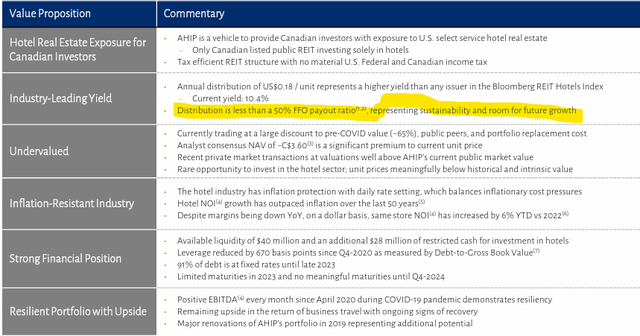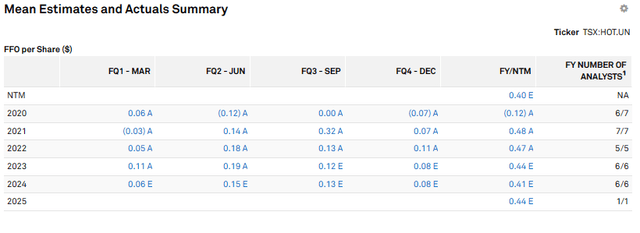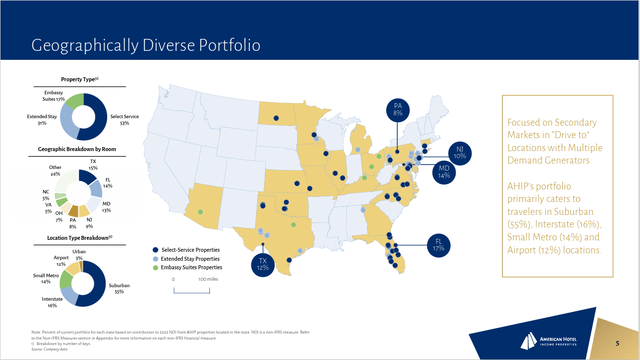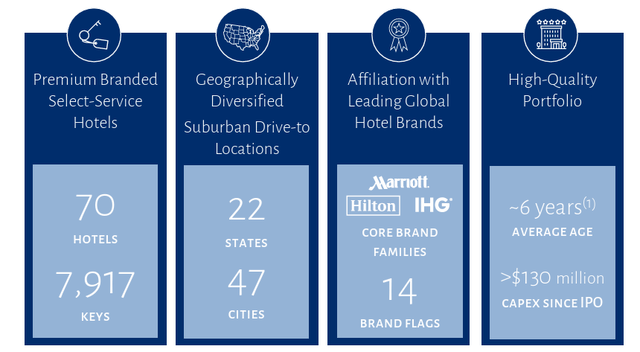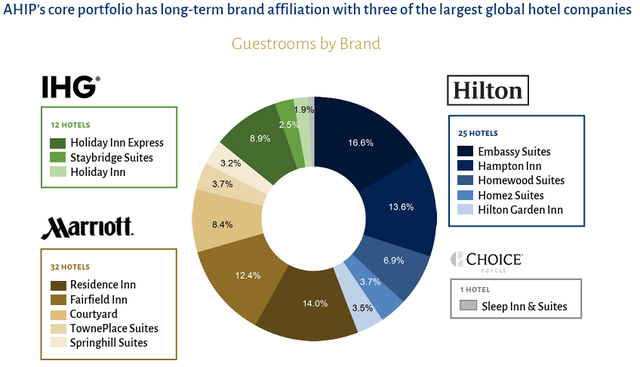American Hotel Income Properties: 10.7% Yield From US Lodging With A Canadian Discount
Summary
- US hotel REIT sector sees stronger operating results in Q2 due to growing business travel demand.
- American Hotel Income Properties (AHOTF) is undervalued compared to its peers, with a high dividend yield and trading at a discount to NAV.
- AHOTF shares are predominantly held by individual Canadian investors, and the company reports financial results and pays dividends in US dollars.
PixelsEffect
Steadily growing business travel demand helped the US hotel REIT sector turn in stronger operating results for the second quarter. Buoyed by strong occupancy and room rate, the sector’s same store revenue per available room (RevPAR) grew 3.8% compared to a very strong 2Q22.
S&P Global Market Intelligence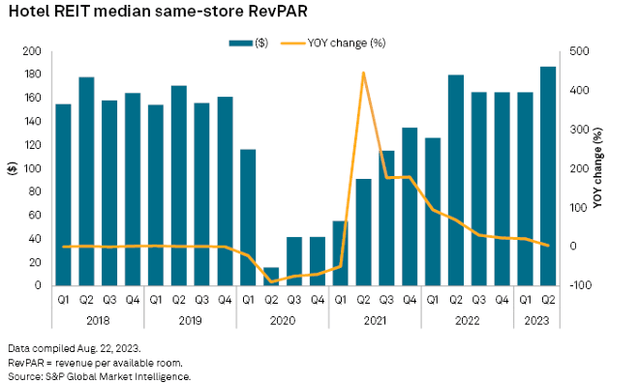
Surpassing pre-pandemic RevPAR metrics, however, hasn’t convinced investors that the sector is opportunistic, and shares are still significantly discounted from their closing 2019 levels. Share price performance over the last twelve months demonstrates no love lost on the lodging sector.
Sector Spotlight: Hotel REITs – 1 year share price performance
S&P Global/ 2MCAC as of 08/23/2023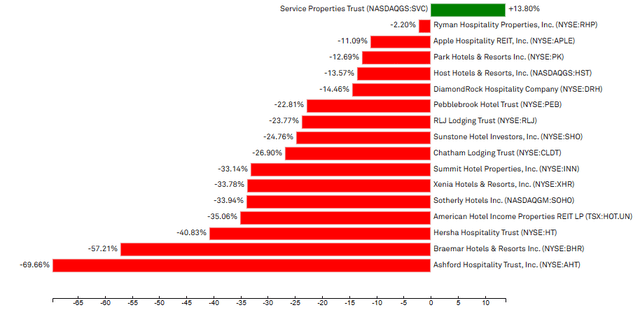
Source: S&P Global Capital IQ/2MC as of 08/23/2023
With the whole sector trading at a consensus estimated 7.8x forward FFO and a double-digit discount to Net Asset Value, we today make the argument that American Hotel Income Properties (OTC:AHOTF) is among the most undervalued of the lot.
Cheaper
The arrival of COVID shut down the world, but almost no industry was as mortally wounded as lodging. Like every hotel REIT suddenly desperate to conserve cash, AHOTF immediately moved to a suspension of its dividend. The shares crashed.
Source: Seeking Alpha
Surprisingly, as operations recovered and American Hotel reinstated a dividend on February 15, 2022, investors seemed to take no notice. The new $0.18/share dividend, payable in monthly distributions, provided an attractive 5.14% yield as measured against the $3.50 share price of 02/15/22, but the shares have continued to slide. At today’s price of $1.64, the dividend produces a stunning 10.97% yield; almost 3x the sector average.
In its most recent investor presentation, management points out that, not only is the dividend sustainable, it equates to a sub 50% payout ratio.
Source: AHOTF
On a value consideration, they note that shares change hands at a huge discount to analyst consensus NAV of C$3.60 ($2.65 USD). For today’s $1.64 share, you pay less than 62% of NAV.
On an earnings consideration, the related consensus indicates the shares are currently trading at 4.08x forecast FFO vs. the sector average of 7.4x.
Source: S&P Global Capital IQ
These basic metrics of yield, discount to NAV, and P/FFO make a reasonably convincing argument that AHOTF shares might be cheaper than those of its peers. It’s less clear as to why.
The Differences
AHOTF is better known, and more widely held, as American Hotel Income Properties REIT LP, which trades on the Toronto Stock Exchange under the ticker (HOT.UN).
The company is headquarted in Vancouver, British Columbia, but its properties are all in the United States.
Source:HOT.UN
Unlike most established REITs, AHOTF/HOT.UN shares are predominantly held by individuals, not institutions. And most of those individuals are Canadian, eh. Our experience with other Canada based REITs with US property portfolios (think BSR Real Estate Investment (OTCPK:BSRTF), Slate Grocery (OTC:SRRTF), or Flagship Communities (OTCPK:MHCUF)) is that they trade at premiums when Canadians are enthused about investing in US real estate and at discounts when they are not. At present, we are not seeing much enthusiasm.
Source: S&P Global Capital IQ
Another difference is the dividend. While AHOTF reports financial results and pays dividends in US dollars, shareholder returns are reported on a K-1 and not your custodian’s consolidated 1099. Though many investors disdain K-1s and avoid them, the reporting affords highly tax efficient treatment of the dividends.
The Similarities
Though AHOTF is a Canadian domiciled enterprise, it reports all of its financial results and pays its dividends in US dollars. The similarities to other US hotel REITs don’t stop there.
AHOTF has more than 7,900 guest rooms in 70 properties scattered across 47 US cities.
Its hotels are flagged by Marriott, Hilton, and IHG. These are brands you will see in other hotel REITs like Apple Hospitality (APLE), Chatham Lodging (CLDT), RLJ Lodging (RLJ), and Summit Hotel Properties (INN).
AHOTF’s mix of extended stay, limited service, and full service hotels are very similar to those in other REIT portfolios. While AHOTF’s discounted share price might be explained by the differences noted above, the discounts are amplified by risks (perceived and real) of investment in the hotel industry.
Hotels are the most beleaguered sector in commercial real estate
The pandemic, government relief programs, high inflation, and higher interest rates have been hard on all business. For the lodging industry, it has been even more difficult.
When COVID shut down all business, it shut off revenues to hotels like turning off a spigot. Though they had no revenues, they still faced operating costs and debt service expenses (like most hotel REITs, AHOTF carries significant debt). Thus, the dividend suspensions and, in many cases, requests for debt forbearance.
When hotels finally reopened, operators experienced supply chain bottlenecks, labor shortages, and inflated wages just like all other businesses. Maybe just more so.
Though leisure travel has robustly resumed, business travel has had a slower recovery. For the 2nd quarter, the whole sector reported improvements in weekday occupancy (business travel), but it still lags 2019 levels.
Higher interest rates negatively impact all real estate and lodging is no exception. As loans have come due, we have seen some REITs elect to turn properties back to their lender, most notably Ashford Hospitality (AHT) and Park Hotels (PK). AHOTF has paid down some indebtedness and hopes to continue to with surplus cashflows, but it remains highly leveraged.
While expenses have inflated across all real estate operations, property and business insurance rates are rising fast. Two AHOTF hotels were damaged in late 2022 extreme weather events. The hotels are now coming back into service, but in their 2Q earnings release, management revealed new related costs:
“As a result of the claims noted above, higher replacement costs and generally higher premiums, AHIP completed its property insurance renewal effective June 1, 2023, with a significant increase in premiums compared to the expiring policy. On an annualized basis, the increase from the prior year is approximately $3.5 million, which will be recognized in earnings over a twelve-month period.”
Rising insurance costs are not unique to AHOTF or the hotel sector, insurance rates are rising ubiquitously. Hotel REITs have been so badly beaten, it might just be harder to woo back investors.
Risk and Reward
We approach investing in hotel REITs with great trepidation. The industry is vulnerable to every bad economic trend, from competition to inflation to recession.
AHOTF’s high dividend and discounted share price are compelling. We are long.
Editor's Note: This article discusses one or more securities that do not trade on a major U.S. exchange. Please be aware of the risks associated with these stocks.
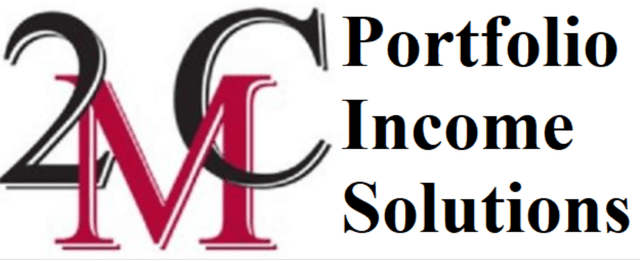
For a full toolkit on building a growing stream of dividend income, please consider joining Portfolio Income Solutions. As a member you will get:
- Access to a curated Real Money REIT Portfolio
- Continuous market commentary
- Data sets on every REIT
You will benefit from our team’s decades of collective experience in REIT investing. On Portfolio Income Solutions, we don’t only share our ideas, we also discuss best trading practices and help you become a better investor.
We welcome you to test it out with a free 14-day trial. Lock in our founding member rate of $33.25/month (paid annually) before it expires!
This article was written by
2nd Market Capital Advisory specializes in the analysis and trading of real estate securities. Through a selective process and consideration of market dynamics, we aim to construct portfolios for rising streams of dividend income and capital appreciation. I am an investment advisor representative of 2nd Market Capital Advisory Corporation, a Wisconsin registered investment advisor along with fellow SA contributors Simon Bowler and Dane Bowler.
Full Disclosure: All content is published and provided as an information source for investors capable of making their own investment decisions. None of the information offered should be construed to be advice or a recommendation that any particular security, portfolio of securities, transaction, or investment strategy is suitable for any specific person. The information offered is impersonal and not tailored to the investment needs of any specific person. Please see our SA Disclosure Statement for our Full Disclaimer.
Analyst’s Disclosure: I/we have a beneficial long position in the shares of AHOTF either through stock ownership, options, or other derivatives. I wrote this article myself, and it expresses my own opinions. I am not receiving compensation for it (other than from Seeking Alpha). I have no business relationship with any company whose stock is mentioned in this article.
All articles are published and provided as an information source for investors capable of making their own investment decisions. None of the information offered should be construed to be advice or a recommendation that any particular security, portfolio of securities, transaction, or investment strategy is suitable for any specific person. The information offered is impersonal and not tailored to the investment needs of any specific person. Readers should verify all claims and do their own due diligence before investing in any securities, including those mentioned in the article. NEVER make an investment decision based solely on the information provided in our articles. It should not be assumed that any of the securities transactions or holdings discussed were profitable or will prove to be profitable. Past performance does not guarantee future results. Investing in publicly held securities is speculative and involves risk, including the possible loss of principal. Historical returns should not be used as the primary basis for investment decisions. Commentary may contain forward-looking statements which are by definition uncertain. Actual results may differ materially from our forecasts or estimations, and 2MCAC and its affiliates cannot be held liable for the use of and reliance upon the opinions, estimates, forecasts, and findings in this article. S&P Global Market Intelligence LLC. Contains copyrighted material distributed under license from S&P 2nd Market Capital Advisory Corporation (2MCAC) is a Wisconsin registered investment advisor. Ross Bowler is an investment advisor representative of 2nd Market Capital Advisory Corporation.
Seeking Alpha's Disclosure: Past performance is no guarantee of future results. No recommendation or advice is being given as to whether any investment is suitable for a particular investor. Any views or opinions expressed above may not reflect those of Seeking Alpha as a whole. Seeking Alpha is not a licensed securities dealer, broker or US investment adviser or investment bank. Our analysts are third party authors that include both professional investors and individual investors who may not be licensed or certified by any institute or regulatory body.
Recommended For You
Comments (2)

Buyers should investigate Canadian taxes and LP structure if held in a tax deferred accounts


